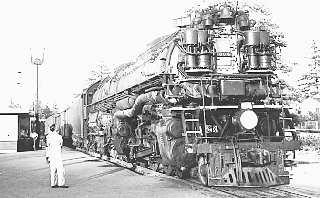Brief History of the SP&S Railway


The Spokane, Portland and Seattle Railway was built by James J. Hill, the "Empire Builder," who also built the Great Northern Railway and who controlled the Northern Pacific and Chicago, Burlington and Quincy railroads. Hill's GN, NP, and CB&Q lines linked Chicago with Seattle. GN and NP trains originally reached Portland via the Oregon Railway and Navigation Company, which followed the south side of the Columbia River for much of its route.
But the wily Edward Harriman, who owned the Union Pacific and Southern Pacific Railroads, took control of the OR&N and denied Hill access to that route. In response, Hill decided to build a new line from Spokane to Portland along the north bank of the river. The new line would be half owned by the Great Northern and half by the Northern Pacific.
Trivia question: The Spokane, Portland and Seattle Railway connected Portland and Spokane, but never reached Seattle. Why was "Seattle" included in the name of the railway? Answer
Completed in 1908, the SP&S main line cost millions of dollars more than expected. This might not have been a problem, but the 1912 opening of the Panama Canal severely reduced transcontinental freight traffic, so the SP&S did not really pay its way until World War II. But it did provide the Hill lines with a water-level route from Spokane to the Pacific Coast and gave Portlanders an important new passenger route.
Hill and his successors used the SP&S to attempt several other incursions into territory Harriman and his successors regarded as their own. Hill bought a line from Portland to Eugene, a Southern Pacific stronghold. He also built from the Columbia River to Bend in an attempt to reach California. Harriman foiled that attempt, but after both of these rail giants passed away the Great Northern continued on down to California.
This route met the Western Pacific at Bieber, California, which connected with the Santa Fe further south, giving the GN an "Inside Gateway" all the way to Los Angeles. This gateway was more-or-less closed when the Union Pacific purchased the Western Pacific, but it may open up again under the BN-UP agreement over the UP-SP merger. In any case, Hill made both the Bend and the Eugene lines a part of the SP&S.
![]()

SP&S Challenger 904 at Camas, Washington, about 1950.
Photo by Jerry Franklin.
The SP&S really came into its own after 1945.
With powerful steam locomotives and a growing fleet of Diesels,
the line billing itself as "the Northwest's Own Railway" was
able to take advantage of the only water-level route from the
west slope of the Rockies to the Pacific Coast. Even the UP
had to contend with the Oregon Blue Moutains, which contain
the steepest grades on that entire railroad.
The post-war SP&S was particularly known for its large fleet of Alco Diesel locomotives. Where most railroads, including the SP&S' parents, bought mainly General Motors (EMD) locomotives, the SP&S endeared itself to Alco fans by buying a large fleet of Alco road and switch engines (though it used EMD units for passenger trains). After the Burlington Northern merger, GN and NP Alco engines were sent to the former SP&S route, where they were familiar to engine crews and shops.
The Hill lines, including the SP&S, merged together into the Burlington Northern in 1970. Trivia question: What was the original name for the newly merged company? Answer
Former SP&S employees still strongly identify with the little road. The SP&S Historical Society publishes a regular newsletter edited by former employees. Former SP&S employees have also strongly supported efforts to restore the SP&S 700, one of only two surviving SP&S steam locomotives.